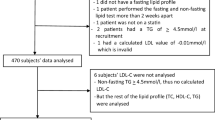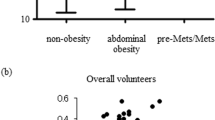Abstract
Background: In patients with metabolic and nutritional disorders such as diabetes and hyperlipidaemia, where strict compliance to advice on timing and composition of food intake is important, the prolonged daylight fasting during the month of Ramadan could produce undesirable biochemical consequences.
Aim: The study aimed to compare pre- and post-Ramadan lipid and lipoprotein profiles in stable Kuwaiti hyperlipidaemic subjects attending a Lipid Clinic.
Subjects and methods: The study population comprised 64 adult Kuwaitis (33 M, 31 F) who had been attending a Lipid Clinic for at least 12 months and were considered stable, without any acute systemic illness. At each clinic visit, the following parameters were measured: weight, total cholesterol (TC), triglycerides (TG), HDL, LDL, apo A-1, apo B, glucose and uric acid. These biochemical parameters were measured by routine automated analyzer techniques. The pre-Ramadan values comprised the means of two measurements taken at about 3 month and 1 month before commencement of Ramadan. Post-Ramadan values were obtained within 1 month of the end of the Ramadan fast. The parameters so obtained were compared in the whole group, and then according to gender, glycaemic status and modality of treatment (diet alone or with a fibrate or statin).
Results and discussion: In the nondiabetic subjects, apo A-1 and apo A-1/apo B and apo A-1/HDL ratios were increased post-Ramadan (P<0.001). Weight did not change and the other lipid parameters—TC, TG, LDL, apo B—did not worsen. These observations, more consistent in the men than in the women, and in subjects treated with a fibrate or a statin rather than on diet alone, indicate a favorable coronary heart disease (CHD) risk profile. In the diabetic patients, these changes in the apo A-1 level and its ratio to HDL and apo B were also present, but TC and apo B levels increased, the latter significantly (P<0.05). These divergent effects in diabetic patients could variably influence CHD risk liability. Serum uric acid levels were also simultaneously reduced post-Ramadan in the non-diabetic subjects and those on statin treatment.
Conclusion: When pre- and post-Ramadan lipid and lipoprotein profiles were compared in stable hyperlipidaemic subjects attending a Lipid Clinic in Kuwait, the most consistent changes post-Ramadan were increased levels of apo A-1 and apo A-1/apo B and apo A-1/HDL ratios and reduced uric acid levels. Body weight remained essentially unchanged and the other lipoprotein and lipid parameters were not worsened. These results suggest that Ramadan fasting in hyperlipidaemic subjects might favorably influence CHD risk.
European Journal of Clinical Nutrition (2000) 54, 508–513
This is a preview of subscription content, access via your institution
Access options
Subscribe to this journal
Receive 12 print issues and online access
$259.00 per year
only $21.58 per issue
Buy this article
- Purchase on Springer Link
- Instant access to full article PDF
Prices may be subject to local taxes which are calculated during checkout
Similar content being viewed by others
Author information
Authors and Affiliations
Contributions
Guarantor: AOA.
Contributors: AOA initiated the study and had overall responsibility for its conduct, data collection and analysis and drafting/editing of the manuscript. OAM was involved in data collection and analysis and editing of the paper. NA was also involved in data generation and analyses and editing of the manuscript.
Corresponding author
Rights and permissions
About this article
Cite this article
Akanji, A., Mojiminiyi, O. & Abdella, N. Beneficial changes in serum apo A-1 and its ratio to apo B and HDL in stable hyperlipidaemic subjects after Ramadan fasting in Kuwait. Eur J Clin Nutr 54, 508–513 (2000). https://doi.org/10.1038/sj.ejcn.1601047
Received:
Revised:
Accepted:
Published:
Issue Date:
DOI: https://doi.org/10.1038/sj.ejcn.1601047
Keywords
This article is cited by
-
A systematic review, meta-analysis, and meta-regression of the impact of diurnal intermittent fasting during Ramadan on body weight in healthy subjects aged 16 years and above
European Journal of Nutrition (2020)
-
Recurrent circadian fasting (RCF) improves blood pressure, biomarkers of cardiometabolic risk and regulates inflammation in men
Journal of Translational Medicine (2019)
-
Serum uric acid increases in patients with systemic autoimmune rheumatic diseases after 3 months of treatment with TNF inhibitors
Rheumatology International (2019)
-
Short-term and Mid-term Effects of Fasting and Downset Meal Pattern on Lipid Profile in Iranian Fasted Women
Journal of Religion and Health (2014)
-
Effects of Greek orthodox christian church fasting on serum lipids and obesity
BMC Public Health (2003)



